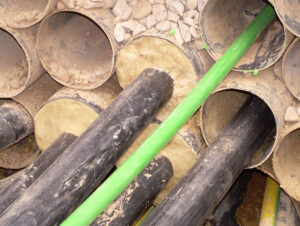 Densoseal 16A sealing mastic by Denso stops water, gas ingress
Densoseal 16A sealing mastic by Denso stops water, gas ingress
November 10, 2021 REDWIRE is news you can use from leading suppliers. Powered by FRASERS.
Posted by Denso North America Inc
Worldwide Suppliers Of Anti-Corrosion, Waterproofing & Sealing Systems For Pipeline Coatings, Steelwork Protection,... Read more
Subscribe
Free REDWIRE e-newsletter

This Denso mastic is ideal for sealing conduits.
Denso North America provides the most diverse portfolio of coatings, tapes, and other solutions for infrastructure protection. For example, the company offers sealing mastic, including the unique Densoseal 16A – a firm, fibrous mastic for ducts and service entries. It is developed to seal conduits and ducts against gas or water ingress.
Based on polybutene, mineral fillers, organic fibres, and water-displacing material, Densoseal 16A is a self-supporting, non-setting mastic in a preformed strip.
Perfect for sealing underground
Densoseal 16A can be applied to wet surfaces, and natural gas and water do not affect it. It is perfect for sealing underground, to stop gas and water from entering buildings. It is also recommended for profiling mechanical joints on high-temperature pipes to allow tape application. This pale yellow Denso mastic has stellar moulding and sealing properties, with no VOCs, and adheres to glazed earthenware, steel, and non-plasticized material like lead, PVC, and polyethylene.
Among the other advantages and features of Densoseal 16A:
- accommodation of movement
- ability to withstand at least 2.9 pounds per square inch of water pressure for more than 30 minutes
- 100 per cent solids content
- flash point above 150 degrees Celsius
- temperature range from zero to 35 degrees Celsius for application, or -15 to 100 degrees Celsius for service
- suitability for underground ducts carrying telephone or electricity supply cables, and for ducts that terminate inside building, manholes, or chambers
Prior to application of Densoseal 16A, the material should be stored for about 24 hours in a temperature between 21 and 41 degrees Celsius. The user begins by rotating each end in a twisting motion in opposite directions until it is mouldable, to make the process easier. Surfaces should be free from loose rust, scale, dirt, or prior sealants.
Then the mastic is packed into the ends of the duct by hand and moulded firmly around cables and against the duct, as the user ensures that there are no gaps or fissures. The mastic should be packed to a depth that is equal to or exceeds the diameter of the duct.
To learn more, contact Denso.
Share
Posted by Denso North America Inc
Worldwide Suppliers Of Anti-Corrosion, Waterproofing & Sealing Systems For Pipeline Coatings, Steelwork Protection,... Read more